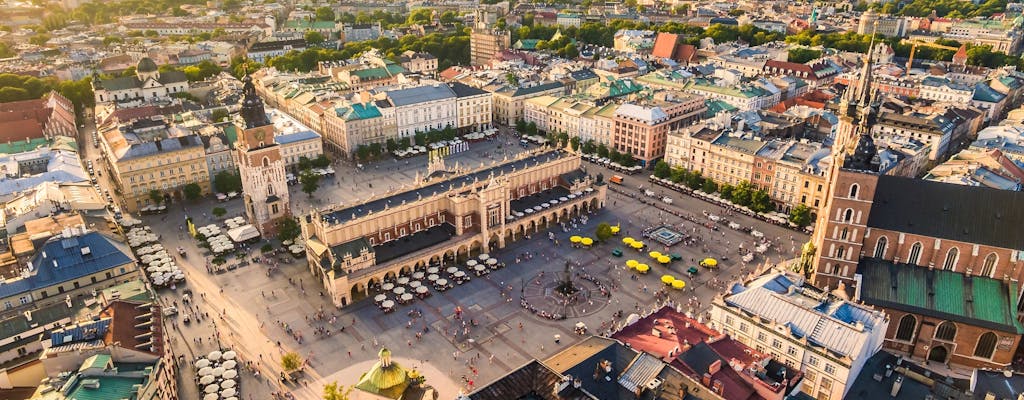Where to go
Poland
Things to do in Krakow
Elegant, vibrant and defiant, Krakow has overcome everything history has thrown at it to become Poland’s where-it’s-at city. On the receiving end of an ongoing facelift since the turn of the millennium, its former glories are resplendent like never before. And best of all, it’s a really easy and enjoyable city to explore by foot. The UNESCO-listed old town is cut in half by the Royal Road, which runs from St Florian’s Church in the north through the main square, Rynek Glowny, all the way to Wawel Hill, a citadel housing the former royal palace and the cathedral. It’s a scenic way to catch all the must-see landmarks and must-visit attractions. Just outside of Krakow are the Wieliczka Salt Mine and Nowa Huta, a ‘model socialist city’ built in the 1950s. The latter hints at Krakow’s dark recent past, which you can explore further in the former Jewish district of Kazimierz, while the Nazi extermination camp of Auschwitz-Birkenau is a 90-minute drive from the city.Top six things to do in Krakow1. Walk the Royal Road to Wawel HillWalking the Royal Road in a straight line takes some 15 minutes. But for a visitor to Krakow, it can take a day, if not days. Starting at the baroque St Florian’s Church, it swerves around the Barbican tower – a relic of the old city walls – and enters into the old town, Stare Miasto, via the Florian Gate, a Gothic tower. The cobbled Floriańska Street leads to the cobbled main square, which deserves time on its own. You then stroll down Grodzka Street, which is flanked by half a dozen churches, including the Church of St Francis of Assisi, famed for its modernist stained-glass windows, floral motif décor and tiles. A guided tour is a great way to learn about all the route’s monuments.2. Admire the glorious Rynek GlownyRynek Glowny is the largest medieval square in Europe. And it’s got a lot going on. The biggest attraction of all is the Cloth Hall, which houses both a bazaar-like gallery full of stalls and a museum. The standalone Town Hall Tower is one of the symbols of Krakow, all that’s left of the old city hall, which was demolished more than 200 years ago. Another iconic sight is the twin-towered, red-brick St Mary’s Basilica. Its wooden altarpiece is a masterpiece of late Gothic craftsmanship. There’s also the tiny Romanesque Church of St Wojciech and the Adam Mickiewicz monument to snap. And every Christmas, the square fills to the scents and sounds of a Christmas market – a real Krakow tradition.3. Visit Wawel Castle and Wawel CathedralA citadel fit for kings and queens, Wawel Hill is the crowning glory of Krakow. From the Italian Renaissance elegance of the tiered courtyard of Sigismund I the Old to the gilded Bird Room, the castle is blockbuster. While the collection of Jagiellonian tapestries, hand-crafted by the finest weavers in the medieval Low Countries, is priceless. The cathedral, meanwhile, is a wonderfully eclectic potpourri of styles, resulting in a riot of colours and shapes. In the crypt, you’ll find the tombs of monarchs, saints, statesmen, poets and other national icons. A tour with an expert local guide is the best way to find out about the hill’s treasures.4. Explore Jewish Kazimierz and Schindler’s FactoryAbout one in three of Krakow’s pre-war population was Jewish. Most lived in their traditional district of Kazimierz, on the other side of Wawel Hill. You can visit the restored Tempel Synagogue, among others, and see the birthplaces of famous local Jews, such as Helena Rubinstein. The Nazis allowed only a fraction to stay, forcing them into a ghetto on the other side of the River Vistula. A section of the ghetto’s wall still stands there, a brief walk from Oskar Schindler’s Factory. Exhibits here tell the story of this Nazi industrialist who saved more than 1,000 of his Jewish workers from certain death as well as of the survivors.5. Uncover the gems of the Wieliczka Salt MineJust a 40-minute train ride from central Krakow lies a vast treasure buried deep below the ground of Wieliczka. This pretty town sits atop a labyrinth of tunnels and chambers adorned with statues carved out of salt. They began digging for salt in the 13th century, and never really stopped – to the point that there are now 287km of tunnels, or the distance from Krakow to Warsaw. The main chapel and its sculpture of the Last Supper is a must. A bit closer to Krakow is Nowa Huta, where Poland’s communist leaders built a ‘workers’ paradidse’ in the austere yet grandiose architectural style known as socialist realism. You can get more context on this and Poland’s recent history with a guided tour.6. Auschwitz-Birkenau Memorial and MuseumThe site of one history’s the greatest crimes is a solemn place rather than a tourist attraction. Visits are usually done in the company of an educator guide, who’ll give a better understanding of the magnitude of what the Nazis did to the inmates in this extermination camp. Its vast size gives you an idea of just how many perished in the unspeakable horrors perpetrated by the SS guards. The museum exhibits mementos of victims and explains in unflinching details the reality of the daily grind in the camps. Regular guided tours with transport depart daily from Krakow. Because of the nature of the exhibits, the camp is not recommended for children under 14 years of age.


